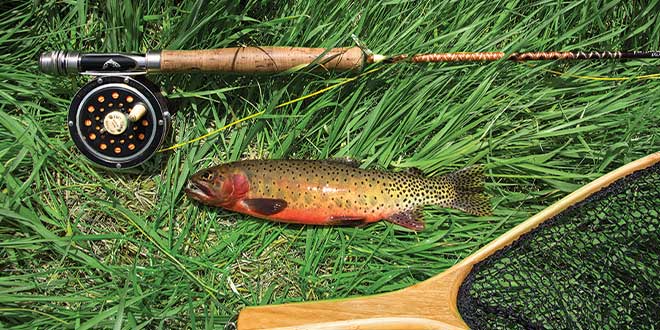Dust off the fly rod and visit local streams for some fun.
The temperatures are nice and the weather is beautiful, which means it’s time to get out for some small- stream trout fishing in the mountains.
This time of year it should be amazing. For those who enjoy catching a 24-inch trout to claim bragging rights, the northwest area will provide a host of opportunities. For me, however, there’s nothing more fun than catching and releasing 20 or 30 pan-size trout while getting some much-needed exercise.
It’s the time of year when stream temperatures have risen and the trout are biting. Water has its greatest density at 38 to 39 degrees and trout usually don’t bite when the water temperature is below 40. It doesn’t mean you can’t catch trout when the water is cooler, but for the best chance at success, the time has come to get outdoors and wet a line.
With this in mind, choosing the right flies for your trip can make all the difference.
There are a few flies I like to have in my box. When it comes to dry flies, parachute Adams and elk-hair caddis are among my favorites. While the parachute Adams passes for a bunch of insects, including the mayfly, the elk hair caddis floats well and, depending on the color, can look like a lot of caddis species and stoneflies.
Because most feeding occurs beneath the surface, I try to limit the amount of dry fly fishing. So, when it comes to nymphs, the pheasant tail is my go-to because the brown-and-olive pattern represents most mayflies.
Choosing the best fly for a day on the water should involve some research on the stream of your choice, which will help determine the best fly based on the insects that occur in the area.
For those new to the sport, it is possible to get carried away with fly-fishing equipment and the expenses can quickly add up. However, it is possible to purchase a fly rod-and-reel for around $60 and, for those wishing to continue mastering this craft, a decision on how much to spend on gear can be made later. I spent a year fishing the San Juan River with a rod-and-reel that cost me $35.
For those anxious to hit the road but still wondering where to go, the northwest area of New Mexico has a number of options. Some of my favorites include the Jemez River, Rio De Las Vacas, Rio Chama and above Gilman Tunnels on the Rio Guadalupe.
However, if you’re itching to catch a big trout, head to the San Juan River. The fish on the San Juan average 16 to 18 inches and it’s rated one of the best trout rivers in the country.
In the end, it really doesn’t matter which of these waters you visit, just get out and fish.
Tips for an enjoyable experience
- Practice your casting before you go fishing. This will make your time in the field more enjoyable and productive.
- Make sure to choose the right fly size. This can make all the difference whether a fish bites or not.
- Do a quick aquatic vertebrae sample to see what is in the stream. This will help determine which fly will work best.
- Pick a spot in the stream where fish are most likely to be present to increase your odds of success. Finding their hiding spots – outside of bends, merging currents, and drop-offs – will help increase your odds of catching some fish.
- Pay attention to the presentation of the fly in or on the water. This is the most important part of fly fishing.
- Most fish feed under the surface, so limit the amount of dry-fly fishing you do.
 New Mexico Wildlife magazine Conserving New Mexico's Wildlife for Future Generations
New Mexico Wildlife magazine Conserving New Mexico's Wildlife for Future Generations
